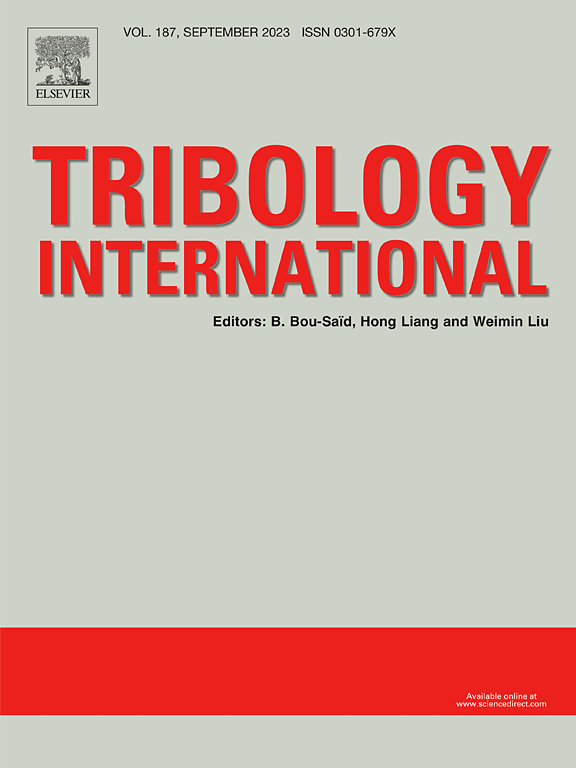Impact of sensitization on wear characteristics of thermo-mechanically processed SS316L: A comprehensive investigation
IF 6.1
1区 工程技术
Q1 ENGINEERING, MECHANICAL
引用次数: 0
Abstract
This study investigates the effect of thermo-mechanical processing (TMP) on sensitization and wear characteristics of austenitic stainless steel 316 L. Solution annealed (SA) material was rolled to induce deformation (4 R and 12 R) and subjected to heat-treatment at sensitization temperatures (400 °C, 600 °C, and 700 °C). Wear tests without lubrication were conducted on these TMP samples to analyze the interplay between sensitization and deformation in influencing wear behavior. Sensitization was observed in deformed samples after heat treatment at 600 °C and 700 °C, as evidenced by Tafel plots. The average coefficient of friction (COF) was found to be higher for SA and lower for 4 R and 12 R samples, but increased COF in the post heat-treatment regime up to 700 °C, indicating sensitization. Deformed sample shows ∼ 9.1 % and ∼ 5.8 % drop in average COF for 4 R and 12 R sample respectively till the onset of sensitization regime (400 °C). However, heat-treatment at the end of sensitization regime (400 °C) attribute to ∼ 7.8 % and ∼ 11.0 % increase in average COF for 4 R and 12 R sample w.r.t. SA sample at room temperature. Volumetric wear loss and wear rate decreased for SA during heat-treatment up to 700 °C, while deformed samples showed a significant increase at 700 °C. Our findings suggest a substantial impact of sensitization temperature above 600 °C on wear behavior in deformed samples, contrasting with the limited effect on SA and subsequently heat-treated samples. The extent of sensitization was observed to depend on the level of deformation. Further, worn surface characterization revealed abrasion and delamination followed by adhesion as dominant wear mechanisms in TMPed SS 316 L under fretting wear conditions.
敏化对热机械加工SS316L磨损特性影响的综合研究
研究了热机械加工(TMP)对奥氏体不锈钢316 L的敏化和磨损特性的影响。将固溶退火(SA)材料轧制变形(4 R和12 R),并在敏化温度(400°C, 600°C和700°C)下进行热处理。对这些TMP试样进行无润滑磨损试验,分析敏化和变形对磨损行为的影响。在600°C和700°C热处理后,变形样品观察到敏化作用,如Tafel图所示。发现SA的平均摩擦系数(COF)较高,4个 R和12个 R样品的平均摩擦系数(COF)较低,但在热处理至700°C后COF增加,表明敏化作用。变形样品显示,在敏化状态(400°C)开始之前,4 R和12 R样品的平均COF分别下降了~ 9.1 %和~ 5.8 %。然而,敏化过程结束时(400°C)的热处理导致4 R和12 R样品在室温下的平均COF增加了~ 7.8 %和~ 11.0 %。当热处理温度达到700℃时,SA的体积磨损损失和磨损率下降,而变形样品在700℃时明显增加。我们的研究结果表明,超过600°C的敏化温度对变形样品的磨损行为有实质性影响,而对SA和随后的热处理样品的影响有限。观察到敏化程度取决于变形程度。此外,磨损表面表征表明,在微动磨损条件下,TMPed SS 316 L的主要磨损机制是磨损和分层,其次是粘附。
本文章由计算机程序翻译,如有差异,请以英文原文为准。
求助全文
约1分钟内获得全文
求助全文
来源期刊

Tribology International
工程技术-工程:机械
CiteScore
10.10
自引率
16.10%
发文量
627
审稿时长
35 days
期刊介绍:
Tribology is the science of rubbing surfaces and contributes to every facet of our everyday life, from live cell friction to engine lubrication and seismology. As such tribology is truly multidisciplinary and this extraordinary breadth of scientific interest is reflected in the scope of Tribology International.
Tribology International seeks to publish original research papers of the highest scientific quality to provide an archival resource for scientists from all backgrounds. Written contributions are invited reporting experimental and modelling studies both in established areas of tribology and emerging fields. Scientific topics include the physics or chemistry of tribo-surfaces, bio-tribology, surface engineering and materials, contact mechanics, nano-tribology, lubricants and hydrodynamic lubrication.
 求助内容:
求助内容: 应助结果提醒方式:
应助结果提醒方式:


